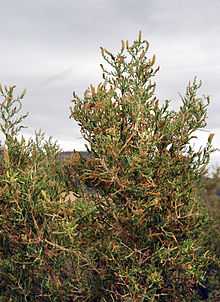Sarcobatus
| Sarcobatus | |
|---|---|
 | |
| Sarcobatus baileyi | |
| Scientific classification | |
| Kingdom: | Plantae |
| (unranked): | Angiosperms |
| (unranked): | Eudicots |
| (unranked): | Core eudicots |
| Order: | Caryophyllales |
| Family: | Sarcobataceae Behnke |
| Genus: | Sarcobatus Nees |
| Species | |
|
see text | |
| Synonyms[1] | |
| |
Sarcobatus, is a North American genus of two species of flowering plants, formerly considered to be a single species. Common names for S. vermiculatus include greasewood, seepwood, and saltbush.[2] Traditionally, Sarcobatus has been treated in the family Chenopodiaceae, but the APG II system, of 2003, recognizes it as the sole genus in the family Sarcobataceae.
Description


The Sarcobatus plants are deciduous[1] shrubs growing to 0.5–3 m tall with spiny branches and succulent leaves, 10–40 mm long and 1–2 mm broad. The leaves are green, in contrast to the grey-green color of most of the other shrubs within its range. The flowers are unisexual, with the male and female flowers on the same plant[1] and appear from June to August. The species reproduces from seeds and sprouts. S. vermiculatus was discovered in 1806 by the Lewis and Clark expedition's westward exploration of North America.[3]
Habitat
The Sarcobatus area of distribution is western North America, from southeastern British Columbia and southwest Alberta, Canada south through the drier regions of the United States (east to North Dakota and west Texas, west to central Washington and eastern California) to northern Mexico (Coahuila).
Both Sarcobatus species are halophytes, usually found in sunny, flat areas around the margins of playas and in dry stream beds and arroyos. It is replaced by iodine bush in extremely saline environments, such as hummocks within the playa itself. Greasewood often grows in extensive, nearly pure stands in pluvial desert locations and is most common on fine-grained soils in areas with a relatively high water table.
Uses
Although it can be grazed by animals that are adapted, grazing of greasewood by sheep and cattle can result in oxalate poisoning resulting in kidney failure.[4] The active agent can be either sodium oxalate or potassium oxalate. Sheep are the most vulnerable. Greasewood was commonly used for firewood by Native Americans and early settlers. The wood is yellow, very hard and tough.[5]
Taxonomy
Sarcobataceae has only recently been published, and such a family has been recognized by very few taxonomists.
The APG II system, of 2003 (unchanged from the APG system, of 1998), does recognize this family and assigns it to the order Caryophyllales in the clade core eudicots. The family comprises the single genus, Sarcobatus. These plants were formerly treated in the family Chenopodiaceae.
Species
The name Sarcobatus comes from Greek sarko (meaning flesh) and batos (meaning bramble), referring to the species' spiny branches and succulent leaves.
The two species are:
- Sarcobatus baileyi Coville is a Nevada endemic.[6] It is a low shrub to 1 m tall.[6] Leaves hairy, 10–16 mm long. Sometimes considered to be a variety of S. vermiculatus, S. vermiculatus var. baileyi (Coville) Jepson. See the Flora of North America for further discussion (which retains the two species as distinct).[1]
- Sarcobatus vermiculatus (Hook.) Torr.. Throughout the range of the genus. Plants are generally 1–2 metres high, although some up to 5 metres high have been recorded.[2] Leaves hairless or only slightly hairy, 15–40 mm long. Synonyms include:[2]
- Batis vermiculata Hooker
- Fremontia vermiculata (Hooker) Torrey
- Sarcobatus maximilianii Nees
References
- ↑ 1.0 1.1 1.2 1.3 Matthew H. Hils, John W. Thieret & James D. Morefield. "Sarcobatus". In Stanley L. Welsh, Clifford W. Crompton & Steven E. Clemants. Flora of North America, volume 4, Chenopodiaceae.
- ↑ 2.0 2.1 2.2 Matthew H. Hils, John W. Thieret & James D. Morefield. "Sarcobatus vermiculatus". In Stanley L. Welsh, Clifford W. Crompton & Steven E. Clemants. Flora of North America, volume 4, Chenopodiaceae.
- ↑ "Lewis and Clark as naturalists". Smithsonian National Museum of Natural History.
- ↑ A. P. Knight and R. G. Walter. "Plants Causing Kidney Failure". In A.P. Knight and R.G. Walter. A Guide to Plant Poisoning of Animals in North America. Teton NewMedia, Jackson WY (www.veterinarywire.com) and International Veterinary Information Service (www.ivis.org), Ithaca, New York, USA.
- ↑
 Rines, George Edwin, ed. (1920). "Greasewood". Encyclopedia Americana.
Rines, George Edwin, ed. (1920). "Greasewood". Encyclopedia Americana. - ↑ 6.0 6.1 Matthew H. Hils, John W. Thieret & James D. Morefield. "Sarcobatus baileyi". In Stanley L. Welsh, Clifford W. Crompton & Steven E. Clemants. Flora of North America, volume 4, Chenopodiaceae.
External links
| Wikimedia Commons has media related to Sarcobatus. |
- Jepson Flora: Sarcobatus vermiculatus
- Extensive description with images explorenm.com, Explore New Mexico
- USDA PLANTS Database
- Canadian Poisonous Plants Information System, Notes on poisoning: Sarcobatus vermiculatus
- Oregon State University, Malheur Agricultural Experiment Station
- Kathy Lloyd and Carole Mackin. "Sarcobatus vermiculatus: Greasewood".
- Sarcobataceae in L. Watson and M.J. Dallwitz (1992 onwards). The families of flowering plants: descriptions, illustrations, identification, information retrieval. Version: 30 May 2006. http://delta-intkey.com
- Flora of North America: Sarcobatus
- NCBI Taxonomy Browser